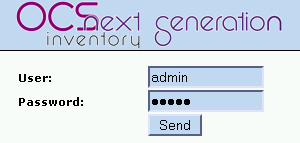Fire up your favorite web browser and point it to the following URL of the OCS-NG server:
http://<ocs-servername>/ocsreports
If we are accessing the OCS-NG web interface from the same machine from where the server daemon is run, we can access the administration console using the localhost instead of using the ocs-servername in the hyperlink syntax previously mentioned. Otherwise, the hostname gets resolved. We can also opt for the IP address of the server instead of hostnames.
The login screen will pop up. It will ask for the User and Password. By default, there is only one predefined user who has administrative privileges. The username is admin and the password is also admin. Type these into the empty text fields and log in.

The password of the predefined admin user can be changed, but that is not what we're going to do. Soon, we will deal with some preliminary configurations, and learn how to set up new users. Next, we can...



